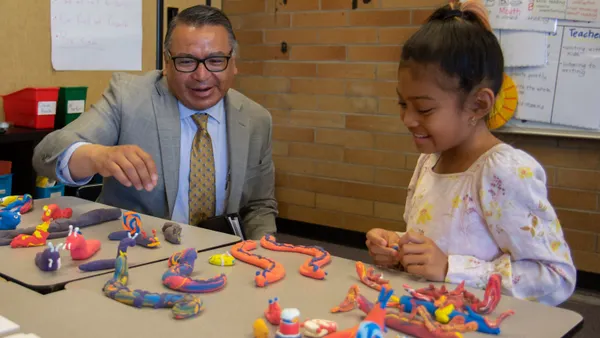Dive Brief:
- The vast majority of teachers (78%) say generative artificial intelligence tools can help them tackle classroom challenges such as managing classroom data, building lesson materials, grading, catching cheating, and differentiating lessons, according to a University of Michigan survey.
- An even higher portion of teachers (85%), however, expressed concerns about student use of AI. A slim majority (52%) said the same about teacher use of the technology, according to a report on the survey results.
- A slight majority of teachers (52%) also said AI was unreliable, and a similar portion of teachers (53%) said they lacked confidence in their ability to use AI in the classroom. But a much larger majority (79%) felt confident they could learn to do so.
Dive Insight:
High school English teachers are perhaps the most hesitant group, although many are responding to concerns about cheating by “flipping the script” and assigning students work in class rather than at home, according to report co-author Joe Mirabelli, a postdoctoral research fellow.
Meanwhile, elementary teachers say AI is not developmentally appropriate because of the amount of screentime it involves, added report co-author Jeanne Sanders, research lab specialist.
About 1,000 K-12 teachers responded to the survey that was administered January through May 2024.
Key concerns included AI not being developmentally appropriate, especially among elementary school students, as well as worries of student cheating among middle- and high-school teachers.
Teachers in rural and urban areas expressed concerns about AI access and whether their students might fall behind the curve, Mirabelli said, given the potential lack of resources.
“You don’t have computers in the classroom, or maybe it’s a cart moving from class to class — are there AI skills that students are going to lose out on, or … state standards they’re going to have difficulty meeting because they don’t have access?” he said.
Sanders added that students in juvenile detention facilities don’t even have access to the internet.
The report focused primarily on how AI can help teachers do their jobs, which has not received as much attention as the impacts on students, Mirabelli said. Teacher respondents overall believe AI can help facilitate work they already do, such as in subjects like math or science where assessments are factual and easy to interpret, as well as “stuff that’s more busywork,” he said. “They see promise in AI quickening their workflow.”
Generative AI also can assist teachers in providing differentiated instruction to students who are moving more or less quickly on a topic than average, Sanders said. But with AI being so new, “one of the things that came up pretty regularly was, ‘Sure it can do new things, but how do I implement it? What are the tools for me?’” she said.
Sanders said teachers are eager to learn: more than 90% said they wanted more support for using AI tools.
And many reported that they don’t know what tools are out there beyond the well-known ChatGPT platform, Mirabelli said. “A lot of these teachers don’t have time in the day to track these tools down,” he said.
Developers of AI tools need to talk directly to teachers as well as district and state level accreditation board members, Mirabelli said. At the same time, superintendents and principals should be creating standardized policies for AI use as well as incorporating structured guidance on how teachers can use AI as part of professional development, he said.
“That’s something teachers in our survey definitely wanted: ‘Can we get some time already budgeted to us, in an existing institute day, in which we can explore AI or get some guidance on it?’” he said. “If you have an anti-cheating policy, here are tools that can help you catch up. Are there lists of approved tools you want teachers, students and parents to be aware of?”
When teachers don’t have that guidance or know if they have the school’s support, it can be difficult to engage in AI tools, Sanders said. “You need to have a policy that’s flexible, recognizing that the policy piece of it is challenging, but also that not doing anything can be a problem.”











